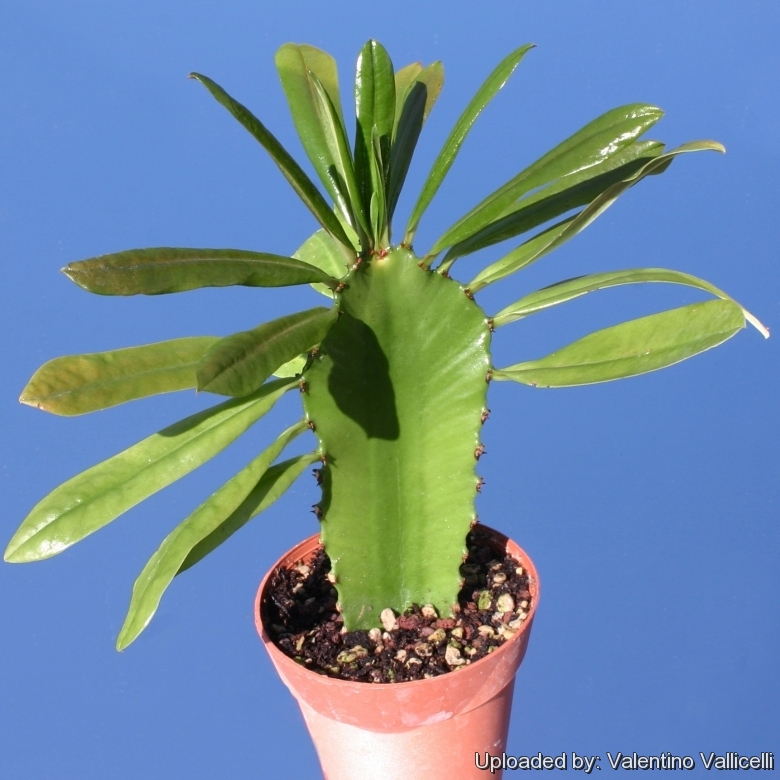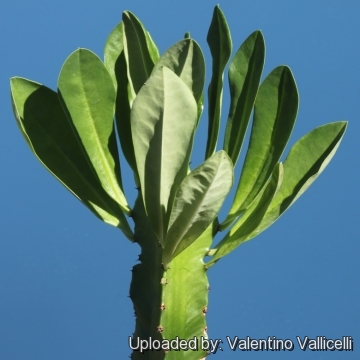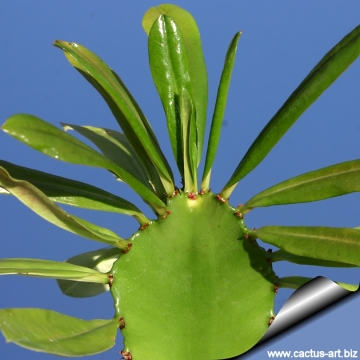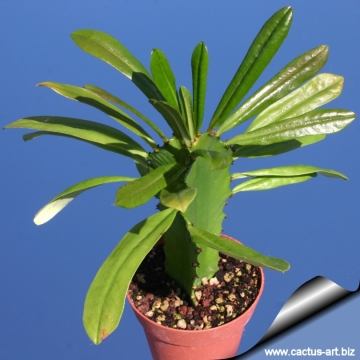Accepted Scientific Name: Euphorbia antiquorum L.
Sp. Pl. 1: 450. 1753 [1 May 1753] L.

Tithymalus antiquorus (Euphorbia antiquorum) Photo by: Valentino Vallicelli
Euphorbia antiquorum is the classic tree spurge of India.
Origin and Habitat: Wide spread throughout peninsular India but wild origin obscure. Escaped or naturalized and widely cultivated in neighbouring regions such Burma, China (Anhui, Fujian, Guangdong, Guangxi, Guizhou, Hainan, Hubei, Hunan, Jiangsu, Jiangxi, Sichuan, Yunnan, Zhejiang), Bangladesh, India, Indonesia, Iran, Malaysia, Myanmar, Pakistan, Thailand, Philippines, Sri Lanka, Thailand, Vietnam and world wide in many tropical zones.
Habitat: Dry ever green forest., up to an altitude of 800 m.
Synonyms:
See all synonyms of Euphorbia antiquorum
back
Accepted name in llifle Database:Euphorbia antiquorum L.Sp. Pl. 1: 450. 1753 [1 May 1753]Synonymy: 5
back
Common Names include:
ENGLISH: Indian Spurge Tree, Malayan Spurge Tree, Square cactus, Sudu, Antique Spurge, Triangular Spurge, Square Spurge, Square milk hedge, Fleshy spurge
ARABIC ( لعربية ): Ghûlaq, Zaqqume-hindi, Zaqqum-hindi
ASSAMESE (অসমীযা়): Siju
BENGALI (বাংলা): Tiktasij, Bajbaran
BURMESE: Sha soung pya thal
CHINESE (中文): 金剛纂, 火殃勒 (Huo yang le), 霸王鞭, 金鋼杵 (Taiwan)
FRENCH (Français): Euphorbe des anciens
GUJARATI (ગુજરાતી): Tansharisehund
HINDI ( हिन्दी): Sehund, Tidhara-sehnr, Tidhara-sehud, टेरॆधारा सेहुनड (Tredhara sehund), वज्र कंटक (Vajrakantaka), Tidhara-sehnel, Tidhara-schnd, त्रिधार (Tridhara), Tidhara-sehna, Tidhara
ITALIAN (Italiano): Euforbio medicinale, Euforbio indiano
KANNADA (ಕನ್ನಡ): Kontekalli, ಚದರಕಳ್ಳಿ, Mulajemudu, Cadarakaḷḷi, Mundukalli, Jadekalli
KONKANI (कोंकणी koṃkaṇī): Tirikon
LAOTIAN (ພາສາລາວ): Chan bat day
MALAY (بهاس ملاي /Bahasa Melayu ): Sudu-sudu, Sedudu, Shadurakalli, Chadurakalli
MALAYALAM (മലയാളം): Chaturakkalli
MANIPURI or MEETEI MAYEK (মৈতৈলোন্): তেংনোউ (Tengnou)
MARATHI (मराठी): Narsej, Navadunga, Nivaduunga, Thridhaari, Naraseja, Narasya
ORIYA (ଓଡି଼ଆ): Vajri, Luhaasijhu
PERSIAN (فارسی): Zaqunniyoe-hindi
RUSSIAN (Русский): Молочай древниx (Molochai drevnikh)
SANSKRIT (संस्कृतम्): वज्रकाण्टक (Vajrakantaka), स्नुह् (snuhu), Vajra, Vajri, सॆहुण्डशाक (Sehuṇḍaśāka), Snuhi
SINHALESE: Daluk, Thaluk
SPANISH (Español): Euforbio malayo, Daluke, Sesudu
TAMIL (தமிழ்): Caturakakalli, Vajṟam, Thiṟuvār kaḷḷi, Kōmoochiṟa valli, xKōmoochiṟa valli, Nānāṅg kaḷḷi, Vachirom, Sathuṟa kaḷḷi, Vacciram, Sathuṟa māṉ kaḷḷi, Nāṉmuka kaḷḷi, Kodiravam, கள்ளி (kalli), கண்டீரவம் (Kantiravam), சதுரக்கள்ளி (chaturakalli - Caturak kalli - Caturakkalli), Tiruvargalli
TELUGU (తెలుగు): Bommajemmudu, Peddajimmadu, Bomajemudu, Peddajemudu, Peddajemmudu, Bontha kl, బొంతజెముడు (Bontha jemudu), బొమ్మజెముడు (Bommajemudu), Peddajamudu
THAI (ภาษาไทย): สลัดได (Sa lat dai)
TURKISH (Türkçe): Faraon sebremi
URDU (اردو): Farftyun, Farfiyun, Farfiun, Farfium
Description: It is one of the largest armed tree Euphorbias, cactus like in appearance with a rugged elegance growing up to an height of 5 - 7 m, branched and rebranched to form a loosely rounded crown, it has been known to attain gigantic proportions if left undisturbed, but usually shrub-like. A small population of giants was discovered by a survey team from the Botanical Survey of India in a secluded part of Kalakkad Reserve forest (alt. 800 m), reaching a height of 20 m and a trunk of 1 m diameter.
Stems: 5-7 cm thick, green, glabrous, branching from upper parts; upward curving, segmented. The odour of its latex is pungent and lingering.
Ribs: 3 (or 4-5) prominent, winglike, up to 1-3 cm wide, 3-5 mm thick, prominently triangular toothed., margins deeply sinuate.
Spines: Paired, sharp, 2-5 mm long, spine shields small, stipules pricklelike.
Leaves: Few, borne on the ridges, succulent, quite insignificant and fall off quickly, alternate, apically clustered, petiole very short, leaf blade obovate, to oblanceolate to spathulate in shape 2-5(-10) × 1-2 cm, base attenuate, margin entire. Apex rounded or obtuse with a small pointed projection, base gradually narrowing downward. Leaves are much more long in the young seedling.
Flowers: Cyathia yellowish-green to pinkish, subterminal, axillary, single or in triads or 3-4 individual cyathia together; peduncles reddish brown; primary peduncle 1 - 1.5 cm long, cyathia peduncle 2-3 mm; all cyathia bisexual; anthers pinkish. Male flower with only 1 stamen, filament short; female flower situated alone at the center of the cyathium, protruding beyond the involucre. Styles 3, not joined to each other, each style forking towards the tip. They are full of honey that attract bees.
Blooming season: Flowers and fruitis all year.
Fruits: Capsules. Glabrous, obscurely lobed, smooth about 8-10 mm in diameter. Green turning deep red on maturity.
Seeds: Globose, ca. 2 mm diameter brown-yellow, smooth.;
Notes: Euphorbia antiquorumSN|21577]]SN|21577]] is the type species for the genus Euphorbia it was described by Linnaeus in 1753 in Species Plantarum, this Euphorbia, whose specific name means 'of the ancients', was one of the two species to be described from India.
Bibliography: Major references and further lectures
1) Edward Balfour "Cyclopaedia of India and of Eastern and Southern Asia, Commercial, Industrial and Scientific: Products of the Mineral, Vegetable and Animal Kingdoms, Useful Arts and Manufactures. Ed. by Edward Balfour, Volume 2" Scottish and Adelphi Press, 1871
2) Urs Eggli "Illustrated Handbook of Succulent Plants: Dicotyledons" Springer, 2002
3) Warrier, P.K., Nambiar, V.P.K. & Ramankutty, C. "Indian Medicinal Plants: A Compendium of 500 Species" Vol 1 - 2 Orient BlackSwan 1994
4)C.P. Khare "Indian Medicinal Plants: An Illustrated Dictionary" Springer, 2007
5) Meena Singh "Euphorbia antiquorum and its Allies" http://www.fgas-sukkulenten.de/downloads/Euphorbia%20antiquorum.pdf retrived on: 17/08/2013
 Tithymalus antiquorus (Euphorbia antiquorum) Photo by: Valentino Vallicelli
Tithymalus antiquorus (Euphorbia antiquorum) Photo by: Valentino Vallicelli Tithymalus antiquorus (Euphorbia antiquorum) Photo by: Cactus Art
Tithymalus antiquorus (Euphorbia antiquorum) Photo by: Cactus Art Tithymalus antiquorus (Euphorbia antiquorum) Photo by: Cactus Art
Tithymalus antiquorus (Euphorbia antiquorum) Photo by: Cactus ArtSend a photo of this plant.The gallery now contains thousands of pictures, however it is possible to do even more. We are, of course, seeking photos of species not yet shown in the gallery but not only that, we are also looking for better pictures than those already present.
Read More... Cultivation and Propagation: Euphorbia antiquorumSN|21577]]SN|21577]] is an easy species to grow that is suited for any well drained soil in full sun. It grows well when there is a layer of brick and charcoal pieces, on top of which sandy loam soil is spread. It needs no maintenance.. But young plant are happy growing indoors, where they can easily reach the ceiling. Give the plant an airy growing medium which mainly consists of non organic material such us clay, pumice, lava grit, and only a little peat or leaf-mould. Water regularly during the active growing season from March to September. No water should ever be allowed to stand around the roots. Keep almost completely dry in winter. It is a moderately fast grower, and will quickly become large landscape masterpieces in just 3-5 years. Only downside is from strong winds, the columns often smash into each other, causing permanent scarring... best to plant in such a location where winds are not a big issue. If plant becomes very red, this is a sign that the roots have not developed properly. It is a relatively fast growing and long lived plant and once established, it will be content in its position and with its soil for years. It can tolerate moderate shade, and a plant that has been growing in shade should be slowly hardened off before placing it in full sun as the plant will be severely scorched if moved too suddenly from shade into sun. Like quite small pots, repott in very later winter, early spring. Can be pruned for shape and branching. Frost tender, like all Indian Euphorbias care should be taken to keep it warm in winter and ensure a minimum temperature of 10° C.
Plant Pests: Prone to mealy bugs and rarely scale.
Propagation: It is easy to propagate from seed or vegetatively in late spring to summer, just take a cutting of the plant let it dry for 1 or 2 weeks and stuff it in the ground (preferably dry, loose, extremely well draining soil).
Warning: All Euphorbias contain a white sap that can be irritating to eyes and mucous membranes. If contact is made with this white sap, take care to not touch face or eyes before washing hands with soap and water.
Uses:
1) Ornamental: The plant is used in parks and gardens for ornamentals and also for protective hedges, due to the fragility of its branches together with the well known skin irritancy of its latex. It can also be kept as an indoor ornamental plant.
2) Traditional medicine: The milk is intensely irritant, euphorbin is the major constituent of the latex. Saline extracts of the stems are antibiotic. It is sometime taken as a purgative, it is also used in rheumatism, toothache, nervine diseases, dropsy, palsy, deafness, to kill maggots in wounds, to clear warts and in contagious skin afflictions. The decoction of the stem is used in gout.
3) Food: Young shoots of the plant are used as a vegetable.
4) Fishing: The latex is a fish poison.
5) Other uses: The dried stalks are the cheapest of firewoods.












